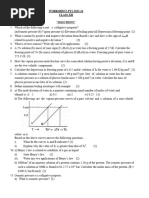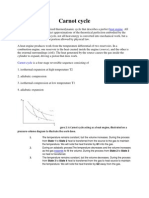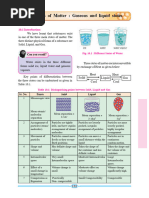0 ratings0% found this document useful (0 votes)
9 viewscpp
Uploaded by
izza fathimaCopyright
© © All Rights Reserved
Available Formats
Download as PDF, TXT or read online on Scribd
0 ratings0% found this document useful (0 votes)
9 viewscpp
Uploaded by
izza fathimaCopyright
© © All Rights Reserved
Available Formats
Download as PDF, TXT or read online on Scribd
You are on page 1/ 3
CPP-01: SOLUTIONS (NCERT BASED)
1. Calculate the mole fraction of ethylene glycol ( ) in a solution containing 20% of
by mass.
2. Calculate the molarity of a solution containing 5 g of NaOH in 450 mL solution.
3. Calculate molality of 2.5 g of ethanoic acid ( ) in 75 g of benzene.
4. Calculate (a) molality (b) molarity and (c) mole fraction of KI if the density of 20%
(mass/mass) aqueous KI is .
5. Calculate the mass percentage of benzene ( ) and carbon tetrachloride ( ) if 22 g
of benzene is dissolved in 122 g of carbon tetrachloride.
6. Calculate the mole fraction of benzene in solution containing 30% by mass in carbon
tetrachloride.
7. Calculate the mass of urea ( ) required in making 2.5 kg of 0.25 molal
aqueous solution.
8. What do you understand by Solubility? On what factors does it depends?
9. Write the statement & expression of Henry’s Law.
10. Explain some applications of Henry’s Law.
11. , a toxic gas with rotten egg like smell, is used for the qualitative analysis. If the
solubility of in water at STP is 0.195 m, calculate Henry’s law constant.
12. Henry’s law constant for in water is Pa at 298 K. Calculate the quantity
of in 500 mL of soda water when packed under 2.5 atm pressure at 298 K.
13. Explain Raoult’s Law. Also write an expression for the same.
14. Vapour pressure of chloroform ( ) and dichloromethane ( ) at 298 K are
200 mm Hg and 415 mm Hg respectively.
(i) Calculate the vapour pressure of the solution prepared by mixing 25.5 g of and
40 g of at 298 K and,
(ii) Mole fractions of each component in vapour phase.
15. (a) Write the differences Ideal & Non-ideal solution.
(b) What are two types of Non-ideal solution, explain with the help of graph.
16. What do you understand by Azeotropes? What are their types? Example with the help
of an example for both the types.
17. The vapour pressure of pure liquids A and B are 450 and 700 mm Hg respectively, at 350
K. Find out the composition of the liquid mixture if total vapour pressure is 600 mm Hg.
Also find the composition of the vapour phase.
18. What do you mean by Colligative properties? Name all the colligative properties.
19. What do you understand by Relative lowering of vapour pressure? Derive an expression
for the same.
FIITJEE DOHA, DPS-MIS Page 1
20. The vapour pressure of pure benzene at a certain temperature is 0.850 bar. A non-
volatile, non-electrolyte solid weighing 0.5 g when added to 39.0 g of benzene (molar
mass ). Vapour pressure of the solution, then, is 0.845 bar. What is the molar
mass of the solid substance?
21. (a) Explain the elevation of boiling point with the help of graph. Also write the
expression for the same.
(b) 18 g of glucose, , is dissolved in 1 kg of water in a saucepan. At what
temperature will water boil at 1.013 bar? for water is .
(c) The boiling point of benzene is 353.23 K. When 1.80 g of a non-volatile solute was
dissolved in 90 g of benzene, the boiling point is raised to 354.11 K. Calculate the molar
–
mass of the solute. for benzene is .
22. (a) Explain the depression of freezing point with the help of graph. Also write the
expression for the same.
(b) 45 g of ethylene glycol ( ) is mixed with 600 g of water. Calculate (a) the
freezing point depression and (b) the freezing point of the solution.
(c) 1.00 g of a non-electrolyte solute dissolved in 50 g of benzene lowered the freezing
point of benzene by 0.40 K. The freezing point depression constant of benzene is
–
5.12 K . Find the molar mass of the solute.
23. (a) What do you understand by Osmosis? What is Osmotic pressure? Explain with the
help of diagram.
(b) What do you understand by Isotonic, Hypertonic & Hypotonic Solution?
(c) 200 of an aqueous solution of a protein contains 1.26 g of the protein. The
osmotic pressure of such a solution at 300 K is found to be bar. Calculate
the molar mass of the protein.
24. What is Reverse Osmosis? Explain with the help of a diagram. What is the application of
Reverse Osmosis?
25. Vapour pressure of pure water at 298 K is 23.8 mm Hg. 50 g of urea ( ) is
dissolved in 850 g of water. Calculate the vapour pressure of water for this solution and
its relative lowering.
26. Boiling point of water at 750 mm Hg is 99.63°C. How much sucrose is to be added to 500
g of water such that it boils at 100°C.
27. Calculate the osmotic pressure in Pascals exerted by a solution prepared by dissolving
1.0 g of polymer of molar mass 185,000 in 450 mL of water at 37°C.
28. Calculate the mass of ascorbic acid (Vitamin C, ) to be dissolved in 75 g of acetic
acid to lower its melting point by 1.5°C. .
29. What do you understand by van’t Hoff factor? Write all the colligative properties in
modified form.
FIITJEE DOHA, DPS-MIS Page 2
–
30. 0.6 mL of acetic acid ( ), having density 1.06 , is dissolved in 1 litre of
water. The depression in freezing point observed for this strength of acid was 0.0205°C.
Calculate the van’t Hoff factor and the dissociation constant of acid.
31. Heptane and octane form an ideal solution. At 373 K, the vapour pressures of the two
liquid components are 105.2 kPa and 46.8 kPa respectively. What will be the vapour
pressure of a mixture of 26.0 g of heptane and 35 g of octane?
32. Suggest the most important type of intermolecular attractive interaction in the
following pairs.
(i) n-hexane and n-octane
(ii)
(iii) and water
(iv) Methanol and Acetone
(v) Acetonitrile ( ) and acetone ( )
33. Determine the amount of (i = 2.47) dissolved in 2.5 litre of water such that its
osmotic pressure is 0.75 atm at 27° C.
34. Benzene and toluene form ideal solution over the entire range of composition. The
vapour pressure of pure benzene and toluene at 300 K are 50.71 mm Hg and 32.06 mm
Hg respectively. Calculate the mole fraction of benzene in vapour phase if 80 g of
benzene is mixed with 100 g of toluene.
35. At 300 K, 36 g of glucose present in a litre of its solution has an osmotic pressure of 4.98
bar. If the osmotic pressure of the solution is 1.52 bars at the same temperature, what
would be its concentration?
FIITJEE DOHA, DPS-MIS Page 3
You might also like
- Hsslive-Xii-Chemistry-Qb-Anil-2. SolutionsNo ratings yetHsslive-Xii-Chemistry-Qb-Anil-2. Solutions4 pages
- Solubility of Solids, Liquids, Gases in LiquidsNo ratings yetSolubility of Solids, Liquids, Gases in Liquids14 pages
- Chemistry Sure Shot Questions 2025 Arvind AcademyNo ratings yetChemistry Sure Shot Questions 2025 Arvind Academy30 pages
- Solutions Booklet Chemistry 241203 101559No ratings yetSolutions Booklet Chemistry 241203 1015596 pages
- Question Chap 1 Solution_50161853_2025_02_07_09_08No ratings yetQuestion Chap 1 Solution_50161853_2025_02_07_09_083 pages
- Hsslive-XII-Chemistry-QB-ch-2. Solutions-SignedNo ratings yetHsslive-XII-Chemistry-QB-ch-2. Solutions-Signed3 pages
- liquid_solution_eng_final_1610097416_removedNo ratings yetliquid_solution_eng_final_1610097416_removed26 pages
- 2024-25 Puc II Chemistry Imp MLL Questions100% (3)2024-25 Puc II Chemistry Imp MLL Questions46 pages
- chemistry previous year questions 2023-24 (1)-1No ratings yetchemistry previous year questions 2023-24 (1)-112 pages
- Liquid Solutions Solution Leader - VK SirNo ratings yetLiquid Solutions Solution Leader - VK Sir82 pages
- Chemistry - Additional Material (Final)No ratings yetChemistry - Additional Material (Final)93 pages
- REVISION ASSIGNMENT FOR HALF YEARLY EXAMINATION 2021-22 _ final (1)No ratings yetREVISION ASSIGNMENT FOR HALF YEARLY EXAMINATION 2021-22 _ final (1)13 pages
- CHAPTER 1 CASE STUDY QUESTIONS WITH ANSWER KEY - Copy (1)No ratings yetCHAPTER 1 CASE STUDY QUESTIONS WITH ANSWER KEY - Copy (1)8 pages
- Buy Ebook Basic Thermodynamics 1st Edition B.K. Venkanna and Swat B. V. Cheap Price100% (14)Buy Ebook Basic Thermodynamics 1st Edition B.K. Venkanna and Swat B. V. Cheap Price70 pages
- Speed and Velocity: Circular and Satellite Motion NameNo ratings yetSpeed and Velocity: Circular and Satellite Motion Name1 page
- A Comparative Study On Three Reactor Types For Methanol Synthesis FromNo ratings yetA Comparative Study On Three Reactor Types For Methanol Synthesis From11 pages
- Oscillations, Waves and Optics (1) - PyqNo ratings yetOscillations, Waves and Optics (1) - Pyq38 pages
- [Ebooks PDF] download Guidelines for Thermography in Architecture and Civil Engineering 1st Edition Torsten Richter full chapters100% (1)[Ebooks PDF] download Guidelines for Thermography in Architecture and Civil Engineering 1st Edition Torsten Richter full chapters40 pages































































































